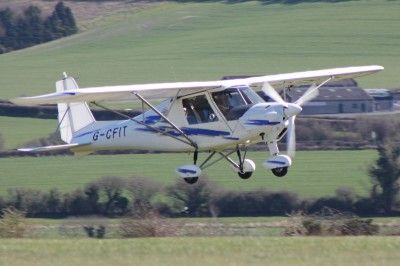Considering another path to the skies — microlights.
Yet again, this should probably have been written in 2010 (much like my first article) but this blog didn’t exist at the time, that’s my excuse anyway.
I’ve wanted to learn to fly for many years and in 2007 had my first ever light aircraft flight back then in a De Havilland Chimpunk.
The thing that put me off was cost, there was simply no way I could continue to afford to train towards my license at that time or that flying club, so it got put on the back burner for many years. In the three years that followed I changed job, moved house, got a puppy etc. But I always wanted to get back up there.
Then I was kindly treated to a longer ‘experience flight’, this time in a microlight at an uncontrolled grass airstrip closer to home. This is a completely different sort of flying — but seems to be right for a lot of people.
The Aircraft
The word microlight conjures up the image of someone attached to a kite with a propeller strapped to it, and indeed this sort of microlight is very common and is known as a flex-wing. It’s not hard to see why either — they’re cheap and comparatively easy to fly.
The aircraft I was introduced to, however, was a fixed-wing microlight — the Ikarus C42 — which has more in common with a typical light aircraft than a microlight, indeed it’s more spacious than the popular Cessna 152 trainer.
The Ikarus C42 Microlight (not the one I flew, but this one has a more amusing registration for the aviation geek in me)
In some other markets these are known as Light Sport Aircraft (LSAs) which I think is a more fitting name — they’re much more capable than what most people think of as a microlight.
The first lesson went much like it did in 2007, and in the interim three years I’d forgotten most of of what I’d learnt — but it was good to get back into the cockpit.
The Ikarus C42 is much more modern than most traditional (formerly known as “Group A” aircraft) you’ll find used for training and it’s also far cheaper to run. It’s nimble, handles well, and is remarkably comfortable.
So why don’t I have one ?
Pros and Cons
Microlights are much more loosely regulated than other aircraft — you can do a lot of the maintenance yourself, as well as install complex uncertified avionics at a fraction of the price of certified ones (you’ll find ‘microlights’ with full glass cockpits and autopilots!)
Ultimately the CAA in the UK is a bit behind the rest of the world in Light Sport Aircraft and they have some fairly noticeable restrictions notably;
- No flight at night
- No flight in instrument weather conditions (IMC)
- Very limited weight means the biggest is a two seater
- International flying is trickier (the most popular license, the NPPL(M), does not permit flying outside the UK)
These put me off unfortunately. Flying is primarily for fun, but it’d be helpful to be able to use it to actually go places — and until the CAA relax some of the above restrictions, it’s a bit of a dead end.
The Flights
Flying in an Ikarus C42 crossing the overhead at Glasgow International whilst a commercial jet waits patiently to depart
I took a number of flights in the Ikarus C42, all of which have proud entries in my logbook alongside ‘real’ planes but I can’t count the hours towards the issue of my PPL(A) license. I did have a fantastic experience with it though, and if you only want to fly for fun — and never want to take more than one passenger — then find an airfield / flying club / microlight club with an Ikarus C42 or a Eurostar EV97, you can’t go wrong :)
A lot of people have said to me that as they’re in a microlight they found it more difficult to get into controlled airspace etc, especially around busy airports.
I really wanted to overfly my house which, unfortunately, was close to the airport so expected to be refused however the friendly air traffic controllers were more than happy to let us into their airspace.
I now expect the reason for this was due to something I would learn to understand when I embarked on my own training in earnest, and got this advice from a friendly air traffic controller;
“If you sound professional on the radio, chances are we’ll let you do what you want. If you hesitate with lots of ‘um’ and ‘er’s or don’t seem to know where you’re going or what you’re asking for — all you’ll get back from us is “Remain clear of controlled airspace”
Decisions, decisions, decisions...
Microlights — especially fixed wing —are a great way to fly, but not for everyone. I was very fortunate to meet the wonderful Colin MacKinnon from Strathaven Airfield early on (it was his Ikarus C42) and he kindly offered very impartial advice, even though it amounted to encouraging me to go elsewhere for training.
If the CAA ever relax the night and instrument flight restrictions on capable little aircraft like the C42, I’d be very tempted to go back to the little grass strip and a Light Sport Aircraft.
